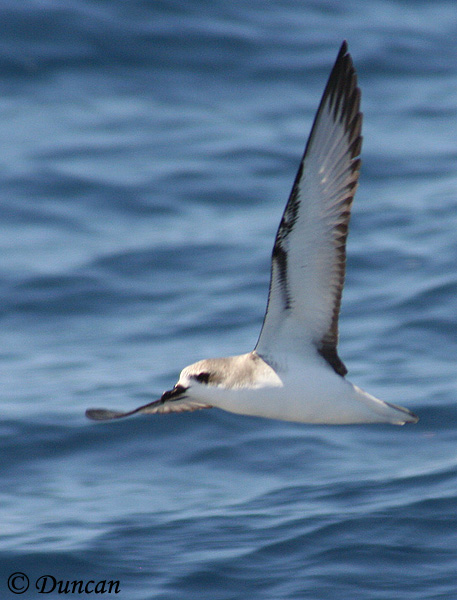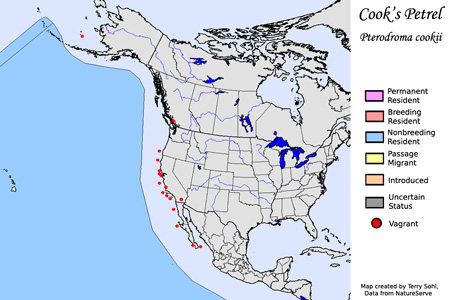| Length: 12 inches | Wingspan: 30 inches | Seasonality: Non-resident in South Dakota |
| ID Keys: Small petrel, white underparts and blanks, light grayish head and back, darker primary feathers, "M" shaped dark mark on upperwings visible in flight | ||
 The
Cook's Petrel is one of the smallest Petrel species in the world. They
likely used to breed across many parts of New Zealand, but now have an
extremely small breeding range, nesting on just three islands near New
Zealand. However, they disperse widely across the Pacific basin
outside of the breeding season, and are regular visitors well offshore of
the West Coast of North America. The accidental introduction of rats and
cats to nesting islands decimated breeding populations in the 20th century,
leading the bird to be considered endangered. However, active efforts
to eliminate predators on their breeding grounds has led to increased
breeding success, and numbers of Cook's Petrels are now increasing again.
The
Cook's Petrel is one of the smallest Petrel species in the world. They
likely used to breed across many parts of New Zealand, but now have an
extremely small breeding range, nesting on just three islands near New
Zealand. However, they disperse widely across the Pacific basin
outside of the breeding season, and are regular visitors well offshore of
the West Coast of North America. The accidental introduction of rats and
cats to nesting islands decimated breeding populations in the 20th century,
leading the bird to be considered endangered. However, active efforts
to eliminate predators on their breeding grounds has led to increased
breeding success, and numbers of Cook's Petrels are now increasing again.
Habitat: Found on a few forested islands near New Zealand when breeding. Outside of the breeding season, they are pelagic, and are typically found well offshore, only very rarely being seen close to shore.
Diet: Feeds mostly on small fish, squid, and crustaceans.
Behavior: Forages by flying low over the water's surface, dipping down to grab prey items when spotted. They will also sometimes grab food items with their bill while swimming on the ocean's surface.
Nesting: The nest of a Cook's Petrel is a burrow with a nesting chamber, typically built on steep forested slopes on their nesting islands near New Zealand. The female lays a single egg, and both parents help to incubate it. Upon hatching, both parents help feed the nestling.
Song: Usually silent away from breeding colonies. Has a series of high-pitched calls made on breeding grounds.
Migration: Breeds in a very limited range, on three islands near New Zealand. Outside of the breeding season, they disperse widely across the Pacific, ranging as far north as the Aleutian Islands, with most birds found well offshore in the eastern side of the Pacific, from North America to South America.
Interactive eBird Map: Click here to access an interactive eBird map of Cook's Petrel sightings
Similar Species: In range, most likely to be confused with the Mottled Petrel or Stejneger's Petrel
Conservation Status: Until recently, the IUCN listed this bird as "Endangered", as populations were in a very sharp decline. The primary reason was that introduced predators such as rats and cats had infested their nesting islands, and greatly decreased nesting success. However, with the successful eradication of rats and cats from their main breeding island, the IUCN has recently upgraded the Cook's Petrel status to "Vulnerable".
Further Information: 1) Birds of New Zealand - Cook's Petrel
2) BirdLife International - Cook's Petrel
3) Audubon Guides - Cook's Petrel
Photo Information: Photo taken by "Duncan" - Photo licensed under Creative Commons Attribution ShareAlike 2.0 Generic License.
| Click below for a higher-resolution map |
 |
| South Dakota Status: Non-resident in South Dakota |
Additional Cook's Petrel Photos (coming soon!!)
